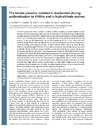Identificador persistente para citar o vincular este elemento:
https://accedacris.ulpgc.es/jspui/handle/10553/6511
| Título: | The lactate paradox revisited in lowlanders during acclimatization to 4100 m and in high-altitude natives | Autores/as: | van Hall, Gerrit Lundby, Carsten Araoz, M. Calbet, J. A. L. Sander, M. Saltin, Bengt |
Clasificación UNESCO: | 241106 Fisiología del ejercicio | Palabras clave: | Hypoxia Lactate Exercise |
Fecha de publicación: | 2009 | Publicación seriada: | Journal of Physiology | Resumen: | Chronic hypoxia has been proposed to induce a closer coupling in human skeletal muscle between ATP utilization and production in both lowlanders (LN) acclimatizing to high altitude and high-altitude natives (HAN), linked with an improved match between pyruvate availability and its use in mitochondrial respiration. This should result in less lactate being formed during exercise in spite of the hypoxaemia. To test this hypothesis six LN (22-31 years old) were studied during 15 min warm up followed by an incremental bicycle exercise to exhaustion at sea level, during acute hypoxia and after 2 and 8 weeks at 4100 m above sea level (El Alto, Bolivia). In addition, eight HAN (26-37 years old) were studied with a similar exercise protocol at altitude. The leg net lactate release, and the arterial and muscle lactate concentrations were elevated during the exercise in LN in acute hypoxia and remained at this higher level during the acclimatization period. HAN had similar high values; however, at the moment of exhaustion their muscle lactate, ADP and IMP content and Cr/PCr ratio were higher than in LN. In conclusion, sea-level residents in the course of acclimatization to high altitude did not exhibit a reduced capacity for the active muscle to produce lactate. Thus, the lactate paradox concept could not be demonstrated. High-altitude natives from the Andes actually exhibit a higher anaerobic energy production than lowlanders after 8 weeks of acclimatization reflected by an increased muscle lactate accumulation and enhanced adenine nucleotide breakdown. | URI: | https://accedacris.ulpgc.es/handle/10553/6511 | ISSN: | 0022-3751 | DOI: | 10.1113/jphysiol.2008.160846 | Fuente: | Journal Of Physiology-London[ISSN 0022-3751],v. 587 (5), p. 1117-1129 |
| Colección: | Artículos |
Vista completa
Citas SCOPUSTM
37
actualizado el 08-jun-2025
Citas de WEB OF SCIENCETM
Citations
30
actualizado el 08-jun-2025
Visitas
150
actualizado el 31-may-2025
Descargas
322
actualizado el 31-may-2025
Google ScholarTM
Verifica
Altmetric
Comparte
Exporta metadatos
Este elemento está sujeto a una licencia Licencia Creative Commons

